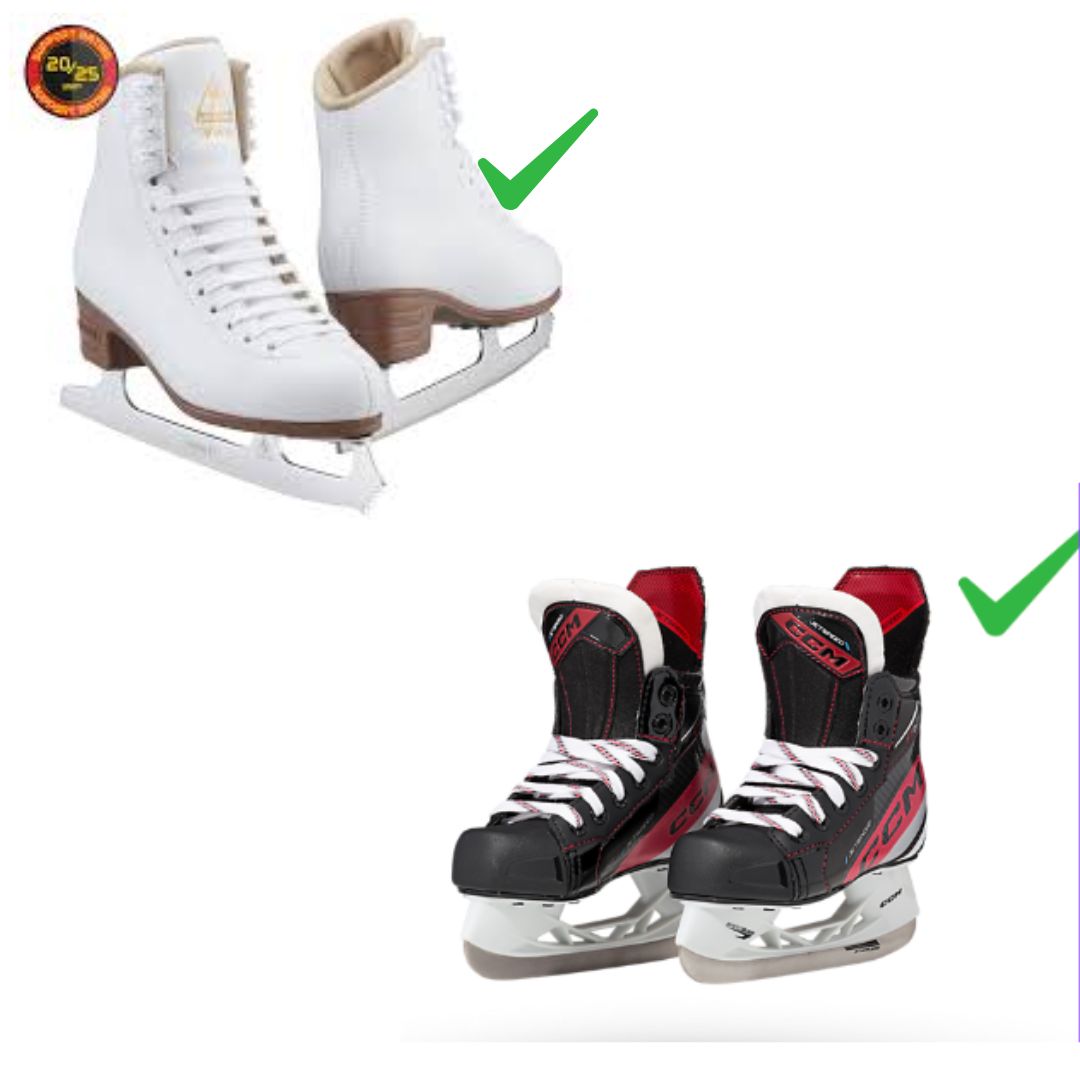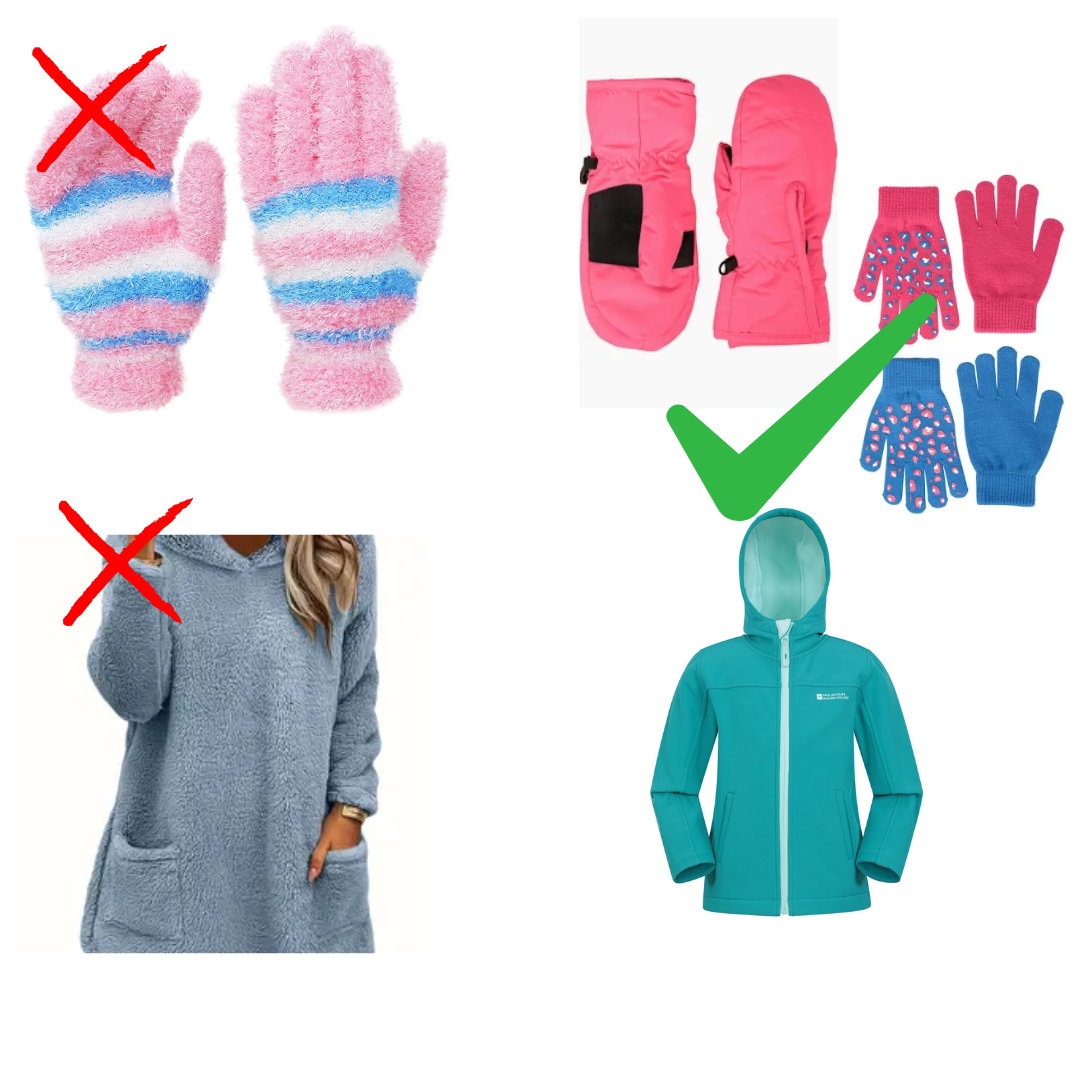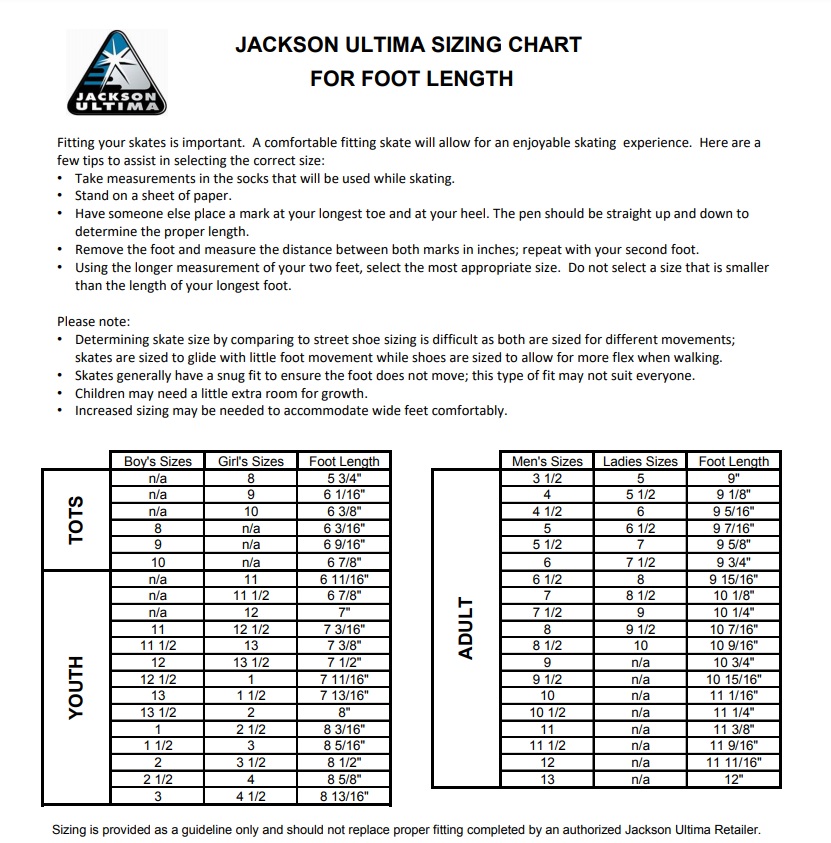Equipment FAQ
 Skates
Skates
There are 4 common types of skates:
- Figure
- Hockey
- Adjustable Size Plastic (not recommended)
- Recreational (not recommended)
We always recommend Figure or Hockey skates whenever possible. These provide proper ankle support and are easier to get a correct fit.
Jackson brand is one that carries toddler size figure skates online. Toddler size hockey skates are easy to find locally in multiple brands.
Skates may not match sneaker size.
If shopping in person, try them on. Keep in mind: Different styles within the same brand may fit differently, and same size but different brands may fit differently. Ensure you tie the skates just like you would to skate, and stand up to test fit.
If shopping online, measure your child's foot and check the size guide for that particular brand. Avoid going too big in anticipation of growth.
Hockey skates tend to be wider and skaters may choose to wear thicker socks. There should be no more than one finger-space behind the heel when the foot is pushed forward in the skate.
Figure skates are often slimmer; higher-end options offer wide boot fits. This is meant to provide ankle support, stability, and avoid slippage during intermediate/advanced moves like spins, jumps and turns. Significant ankle creasing indicates that a more supportive pair is necessary.
CARE
Figure skates should have a toe pick on them. Never shave off your toe pick; it will only make it harder to learn later.
Skates should be sharpened before the season and approximately every 3 months.
- Figure skates require a different sharpening technique due to their blade shape - not all sharpeners are able to support this option.
Those with figure skates should wear somewhat of a thin sock and lace the skate starting from the toe and all the way up. There are various methods and videos available online, like this one.
Do not wrap laces around the ankle on figure skates. If the laces are long, hook them twice around the hooks.
Wear rubber or plastic skate guards when walking around the rink to avoid getting dings in your blades. DO NOT STEP ON HARD SURFACES LIKE CONCRETE.
When you finish skating: never leave plastic or rubber guards on your skates in your bag as this will make them rust. Instead dry your blades and boots completely and put on fabric blade covers or nothing at all.
How to Tie Figure Skates
Thin, smooth, tall socks will help avoid leg irritation but are personal preference.
Ensure there are no long, hanging laces which can catch in skate blades - tuck under legwarmers, or continue to tie laces around hooks as usual before finishing in a double knotted bow.
.jpg) Helmets
Helmets
Everyone must wear a CSA approved hockey helmet on the ice. Helmet must have its original CSA sticker on it.
Helmet facemasks are optional, recommended for new and/or skaters <6 years old.
We cannot allow ski or bike helmets on the ice.
Helmet straps must be clicked in and worn snug so the helmet stays on securely.
Please tape your skater’s name on the front of their helmets!!
*Figure skaters may take helmets off eventually when they reach a certain Skate Canada level, we will inform you when your skater has achieved this point. It is up to guardian discretion; there is no penalty for your skater keeping helmet on.

What to Wear
Skaters wear skates, helmets, non-fuzzy gloves or mittens and layers of comfortable clothes.
Precanskate & our youngest Canskaters often wear snowpants, splash pants, or snowsuits.
Some beginners will wear elbow and knee pads; this is optional.
Adult beginners are welcome to wear knee, elbow and wrist guards until they feel confident on their feet.
Wear clothing that is stretchy and fitted to the body and allows movement like deep knee bends.
Do not wear anything long or hanging that skaters could trip over or get hooked in (for example, Oodies, scarves outside a jacket, dangling hoodie strings, very wide-leg pants that aren’t tucked in, etc)
Hair should be tied back as best as possible to avoid it getting in their eyes/mouth.
*AVOID fuzzy or sherpa materials - they will stick to the ice and create a safety hazard*
Need help choosing Figure Skates? Click Here for More Tips
There are differences in fit between brands; however in general these measurement tips can be used to help you select the right size. Most brands have similar sizing advice on their websites.
As skaters grow and advance, they will need to select skates that can support more advanced moves. These generally will have stiffer boots providing more support, requiring a "breaking-in" period. The pick on their skate may also be more pronounced. Skaters sometimes need an adjustment period over a few sessions, where it may feel like they are re-learning moves that came easier to them and their feet may be tired sooner. This is normal. However, if their feet are painful or you're unsure about the fit, please speak to the coaching team.
**Some high-end skates can be baked for a more custom fit. Introductory level skates CANNOT be baked!
Baking instructions will be different compared to hockey skates; ensure you follow the instructions for your particular skates from the brand website and provide them to the technician**


